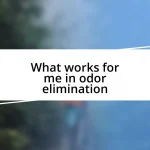Key takeaways:
- Choosing carpet protection products requires understanding individual lifestyle factors like foot traffic, pets, and maintenance preferences to ensure the right fit.
- Evaluating products involves considering application ease, materials’ durability, and environmental impact, emphasizing the importance of research and customer feedback.
- Making informed decisions includes creating a checklist of essential features and comparing options to avoid common pitfalls and select effective carpet protectors.

Understanding carpet protection needs
When I first moved into my home, I quickly realized that not all carpets are created equal, and their protection needs can vary significantly. Did you know that factors like foot traffic, household pets, and even the climate can impact the type of protective solutions you should consider? For instance, after watching my dog track muddy paw prints across the living room, I learned the hard way how essential it is to choose durable, stain-resistant materials.
I remember the day I spilled red wine on my new cream carpet at a dinner party. The panic that set in made me wish I had embraced some preventive measures earlier. This experience taught me that understanding my lifestyle—including social gatherings and the presence of kids—shapes my decisions regarding carpet protection products. It’s not just about keeping the carpet looking good; it’s about maintaining its lifespan and reducing my stress over potential mishaps.
Have you ever considered how the level of maintenance you’re willing to commit to plays a role in choosing the right protection? I realized that I needed products that not only shielded my carpet but were also easy to clean and maintain. The right choice transforms how I enjoy my living space, allowing me to entertain without constantly worrying about potential stains or damage.

Evaluating carpet protection options
When I started my search for carpet protection options, I found myself faced with a dizzying array of products. From sprays to protective mats, each option promised something different. Reflecting on my past experiences, I noticed that the method of application often influenced not just the results but also my level of comfort with the product. For example, I had a frustrating encounter with a spray that left a sticky residue, making my carpet feel more like a sticky trap than a cozy haven.
One pivotal moment for me was when I decided to invest in a carpet protector after hosting a family gathering. You can imagine the chaos that ensued—spilled juice, crumbs everywhere, and my young niece dancing with chocolate-covered fingers. Choosing a product with a quick-drying formula not only made clean-up easier, but it also gave me peace of mind. In my experience, when evaluating carpet protection options, I strongly recommend considering how quickly the product renders the carpet usable again. It’s these little details that can make a world of difference in your home.
Testing carpet protection products can often feel daunting, but I discovered that reading reviews and even seeking advice from friends led me toward the best options. When a friend swore by a particular brand that was eco-friendly, I dove into research to see if it aligned with my needs. This exploration reassured me that a thoughtful approach to evaluation can uncover hidden gems within the market, even among the seemingly endless choices.
| Product Type | Key Features |
|---|---|
| Spray Protector | Easy application, quick drying, but may leave a residue. |
| Protective Mats | Durable and great for high-traffic areas, but can be heavy and less aesthetically pleasing. |
| Eco-Friendly Options | Safe for pets and children, but can be pricier and may require more frequent reapplication. |

Comparing materials and durability
As I delved into the materials used in carpet protection products, I quickly realized the significant impact each option has on durability. I vividly recall a time when I chose a thin, inexpensive protector, only to find it frayed after a few weeks. The thought of having wasted money—and time—made me reconsider my approach. It’s crucial to balance cost with effectiveness, as some materials, like heavy-duty vinyl or polyester, can withstand more wear and tear while providing substantial stain resistance.
Here’s a quick breakdown of popular materials and their durability:
- Vinyl: Known for its excellent stain resistance and ability to withstand heavy foot traffic, making it ideal for busy homes.
- Polyester: Offers vibrant colors and a soft feel but may not be as durable under extreme conditions.
- Nylon: Highly resilient, this material can bounce back from pressures and is a champion in stain resistance.
- Wool: While on the pricier side, wool is naturally resilient and offers great performance with proper treatment, though it requires more upkeep.
Reflecting on these choices reminds me of the times I opted for convenience over durability during high-traffic seasons in my home, only to be left with a carpet that looked tired and worn. If I had chosen a material designed for longevity, it would have saved me both time and heartache, reinforcing the lesson that while it may be tempting to skimp, investing in quality can pay off in spades.

Assessing ease of application
When I was exploring carpet protection products, one thing that really stood out to me was the ease of application. For instance, I remember trying a spray product that claimed to be user-friendly. However, I was taken aback by how complicated it actually felt. The nozzle clogged repeatedly, and I found myself wrestling with it just to get a decent coverage. I wondered, “Is my time worth this frustration?” The answer was a resounding no.
Conversely, I had a much better experience with a carpet protector that came in a roll. It was straightforward to lay down and required little more than unrolling and positioning. I felt an instant sense of relief as I realized how simple it could be—no straining to maneuver or waiting forever for it to dry. When assessing ease of application, I consider how well the product fits into my lifestyle. If it complicates my life, I don’t want it in my home.
In the end, the products I felt most comfortable with were those that allowed for quick adjustments. I vividly recall applying a liquid protector and quickly realized I could wipe away any overspills without a hassle. This flexibility made me feel I was in control rather than fighting against the product. Isn’t that what we all want when looking to protect our carpets—something that works seamlessly with our daily life, not against it?

Considering environmental impact
When I consider the environmental impact of carpet protection products, it really brings to light the importance of choosing eco-friendly options. I remember a time when I randomly bought a product without checking its ingredients, only to discover later it contained harmful chemicals. Knowing that my choice could affect not just my home but also the planet was a wake-up call. Now, I make it a point to research whether a product is biodegradable or made from recycled materials.
It’s also essential to think about how these products are manufactured. I once participated in a workshop about sustainable practices in home products, and it opened my eyes to how much energy and resources are used in production. By opting for brands that prioritize sustainability, I feel like I’m supporting a greener future. Have you ever thought about where your products come from? This perspective truly changed my purchasing habits and made me more conscientious in selecting carpet protectors.
Additionally, I’ve started to pay attention to certifications—labels that indicate a product meets specific environmental standards. I recall finding a carpet protector that boasted a low VOC (volatile organic compounds) rating. It wasn’t only reassuring; it also gave me peace of mind knowing I was doing my part to reduce indoor air pollution. Making choices that are kinder to the environment not only supports my home but also aligns with my values, creating a space I can feel good about living in.

Reviewing customer feedback
When diving into customer feedback, I find that it offers a treasure trove of insights I can’t get anywhere else. I remember reading reviews on a carpet protector that had a magnetic appeal, but many customers pointed out how its scent lingered much longer than they anticipated. This made me ponder: if I’m going to use a product regularly, do I really want my living room to smell like a chemical factory? Honest feedback like this helps me anticipate potential pitfalls before making a purchase.
Moreover, I always look for recurring themes in customer comments. Once, I noticed a product frequently praised for its stain-repelling power, but quite a few voices chimed in with concerns about its residue on carpets. It reminded me of my own experience with a similar product that left a sticky film, leaving me questioning if the short-term benefits were worth the long-term issues. This kind of transparency in reviews invites me to consider not just the initial application but how the product might impact my carpets over time.
Sometimes, I find myself combing through testimonials to see if users share their stories about unexpected challenges. For instance, one user vividly described a pet accident that seemed hopeless but was easily cleaned up thanks to the carpet protector they chose. That real-life scenario struck a chord with me; it highlighted how the right choice can turn a potential disaster into just another moment in life. Isn’t it reassuring to hear that others have navigated similar situations successfully? These personal experiences help me connect and feel more confident about my decisions.

Making an informed decision
Making an informed decision involves gathering as much information as possible before committing to a product. I often spend time comparing options, looking up ingredients, and considering different brands’ features. For instance, when I faced a carpet mishap from a spilled drink, I realized that the protector I had chosen lacked the stain resistance I needed. That experience taught me the value of not just trusting marketing claims but doing my own homework to ensure I’m choosing wisely.
I’ve found that consulting various sources, from expert reviews to user experiences, enhances my decision-making process. When I came across a blog that detailed the effectiveness of several carpet protectors, it felt like I was having a conversation with someone who had already tried them all. One product’s supposed durability stood out, but the negative feedback about its application process made me think twice. These insights allow me to weigh benefits against potential drawbacks, ensuring I don’t end up with another product that disappoints.
Moreover, I’ve started to develop a checklist of criteria that matter most to me, which has made the decision-making much clearer. Features such as ease of use, effectiveness, and environmental responsibility top my list. For example, after reading about a protector that was praised for its user-friendly spray application, I felt more inclined to give it a try. Doesn’t it make sense to prioritize usability along with performance? By keeping my checklist in mind, I not only feel empowered but also more confident in my choices about carpet protection products.














